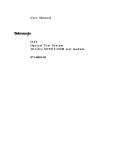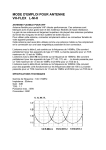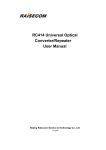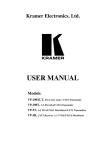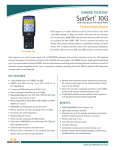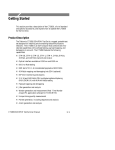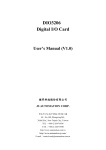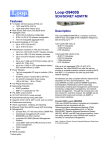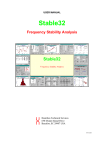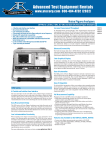Download APPLICATION NOTE
Transcript
® E stablished 1981 Advanced Test Equipment Rentals www.atecorp.com 800-404-ATEC (2832) APPLICATION NOTE May 17, 2002 Subject: Generating and Analyzing Wander Using the OTS Product Family Introduction This document outlines suggested methods for generating and analyzing SONET/SDH signal wander as part of an overall Tektronix supplied jitter and wander solution. As such, these procedures utilize the popular industry standard Tektronix SJ300E Jitter and Wander Generator and Analyzer instrument to supply wander generation and analysis functions while the OTS9210 module provides the framework around which both jitter and wander tests may be easily completed. While these procedures describe wander testing methods for 10Gb/s SONET/SDH signals, these procedures may also be applied for SONET/SDH wander at 2.5 Gb/s using the OTS9300 Multi-rate option. Test Equipment The following test equipment and miscellaneous apparatus may be required to perform these tests: • • • • • • • Tektronix OTS9000, OTS9010 or OTS9040* test systems equipped with OTS9210 jitter solution. Tektronix OTS9100 10G or OTS9300 155M/622M/2.5G Transmission Test Solution Tektronix OTS92S1 Clock/Sync card option. Tektronix SJ300E SONET/SDH Jitter and Wander Generator and Analyzer equipped with Option 06 (Wander). A BITS or SETS clock synchronization reference source meeting Stratum 1 clock standards. A SONET or SDH network element (Device Under Test). Miscellaneous cables, connectors and adapters as required to interconnect various test configurations. *Note: The OTS9040 may be used to perform both jitter and wander tests but will require minor OTS system reconfiguration due to the limited number of backplane card slots available. Wander Testing Concepts The proposed wander testing concepts are centered on the capabilities of the SJ300E Wander Analyzer instrument. Using a combination of the SJ300E Wander Analyzer and the OTS9210 jitter test solution, both wander generation and wander analysis can be easily performed. The basic wander test concepts used are as follows: Wander Generation: OTS9000 OTS92S1 Clock/Sync Stratum 1 SJ300E 10 Gb/s Optical Signal Wander Generator Sync Source BITS = 1.544 Mb/s SETS = 2.048 Mb/s The SJ300E wander generator is used to add wander to a BITS or SETS (Stratum 1) reference signal connected to the OTS92S1 Sync module, which in turn is used to supply the clock for the OTS91T3 10Gb/s SONET/SDH transmitter card. This 10Gb/s optical output signal may then be applied to SONET/SDH network elements for wander testing, i.e., wander tolerance, etc. Wander Analysis: Stratum 1 OTS92R1 Jitter Receiver Wander Analyzer Sync Source SJ300E 10Gb/s Optical Signal 622 Mb/s Recovered Clock OTS9000 BITS = 1.544 Mb/s SETS = 2.048 Mb/s The incoming 10Gb/s SONET/SDH signal clock is recovered in the OTS92R1 Jitter Receiver card (622 Mb/s selectable) where it is connected to the SJ300E Wander Analyzer. The wander component is then measured and analyzed. The SJ300E Wander Analyzer is used to compare the BITS or SETS Stratum 1 reference clock to that of the recovered SONET/SDH clock signal and provide accurate wander analysis. OTS System Configuration The diagram below shows a typical OTS system configured for 10Gb/s jitter and wander measurement capabilities: OTS9000, OTS9010 or OTS9040 * 1 2 3 4 5 6 7 8 10Gb/s Optical OTS91L1 10G Optics OTS91R2 10G Receive OTS91T3 10G Transmit OTS91C3 10G Clock Trigger OTS92S1 Synchronization OTS92T1 Jitter Transmit OTS92R1 Jitter Receive OTS92H1 Jitter Clock Recovery *Note: The OTS 9040 mainframe may only contain a maximum of seven OTS cards. The OTS92T1 Jitter Transmit card is not required for wander generation or wander analysis using these procedures and may be removed allowing the OTS92S1 card to be installed. Note that the OTS92S1 card must always be installed in the highest numbered card slot. Only one OTS92S1 card may be installed in any single OTS system. Caution: OTS slot number versus card placement is not arbitrary. Always refer to the latest Tektronix OTS configuration guide to ensure card installation is configured properly. The configuration shown is currently the only allowed configuration for the OTS9010 and OTS9040 mainframes using the cards shown. Wander Generation Test Configuration The diagram below shows the SJ300E and OTS system wander generation test connections. OTS92S1 Clock/Sync OTS9000 1 2 3 4 5 6 7 8 1.5 Mb/s or 2 Mb/s In BITS Out 10Gb/s Optical Signal Stratum 1 SJ300E REF CLOCK (Sync) IN Sync Source L1 R2 T3 C3 H1 R1 T1 S1 OTS91T3 10G Data Transmitter uses backplane clock source BITS = 1.544 Mb/s SETS = 2.048 Mb/s Configuration details: 1. Access the OTS92S1 card in the OTS GUI and select 2 Mb/s or 1.5 Mb/s external clock option depending on the reference synchronization signal source used. Note that a 1.544 Mb/s BITS clock reference signal connects to the small Bantam connector at the bottom of the OTS92S1 card whereas the 2.048 Mb/s SETS reference clock signal connects to the adjacent SMA connector. 2. Using the OTS91T3 10Gb/s transmitter card configuration menu, select the “backplane” timing option. 3. On the SJ300E front panel, select “EXT” as the REF CLOCK synchronization input source. The SJ300E “Ext” front panel Green LED should be lit. Connect a BITS or SETS synchronization signal to SJ300E REF CLOCK jack. 4. Access the SJ300E WANDER menu and use the REF SEL option to select the correct signal input type, i.e., DS1 (1.544 Mb/s), or E1 (2.048 Mb/s). 5. On the SJ300E rear panel, connect the BITS Out jack to the OTS92S1 1.5 MB IN jack. If a 2.048 Mb/s SETS reference signal is used, connect this reference clock signal to the 2MB/s IN jack. Ensure the OTS92S1 “Lock Status” indicators are Green. Do not proceed until the OTS92S1 reference clock status indicators show a successful reference clock lock condition. 6. Connect the OTS91L1 10Gb/s optical output to the DUT (Device Under Test) or in the test configuration requiring a 10Gb/s wandered signal. Activate the OTS 10Gb/s laser and verify a good 10Gb/s optical signal is detected by the DUT. This may require selection of a particular 10Gb/s data signal payload and/or overhead signal to match that required by the DUT, etc. 7. Access the SJ300E WANDER menu and select the desired wander generation signal. Note that depending on the reference signal used, the choice of wander generation selections vary, e.g., either a standard TDEV value or industry standard choices. Pressing the SJ300E “Enter” button will activate the SJ300E wander generator function and “wander” the OTS9000 10Gb/s electrical and optical output signal. Notes: A. BITS clock signal is a DS-1 framed “all one’s” signal at Stratum 1 level accuracy (network synchronization reference source). B. SETS clock signal is an E-1 framed “all one’s” signal at Stratum 1 level accuracy (network synchronization reference source). C. The OTS9300 “Multi-rate” test option may replace the 10Gb/s test option described above and permit wander testing at 2.5 Gb/s, 622 Mb/s and 155 Mb/s SONET/SDH rates. Wander Analysis Use of the SJ300E and OTS system combination provides a reliable means by which SONET/SDH signal wander analysis may be accomplished. The diagram below shows the suggested wander analysis test configuration. (10 Gb/s testing) 622 Mb/s selectable Stratum 1 Sync Source BITS = 1.544 Mb/s SETS = 2.048 Mb/s REF CLOCK (Sync) Wander Analyzer Recovered Clock Out Receiver Clock In SJ300E OTS92R1 Jitter Receiver Configuration details: 1. Connect the OTS system equipped with OTS9210 jitter option to the SONET/SDH signal to be analyzed. 2. Verify the quality of the received SONET/SDH signal, i.e., error free signal, low SNR, etc. 3. The OTS receiver is normally configured to recover a clock signal from the received signal. Ensure the OTS data receiver is configured properly. Access the OTS92R1 “Setup” menu and ensure the 622 Mb/s recovered clock is selected (default option for 10Gb/s signals). 4. Connect a 1.544 Mb/s BITS signal or a 2.048 Mb/s SETS reference signal to the SJ300E front panel “REF CLOCK” input jack. Ensure the EXT button is Green indicating the clock source is external. Using the WANDER menu, use the REF SEL option to select the correct clock reference signal type. 5. Connect the 622 Mb/s recovered clock signal from the OTS92R1 receiver to the SJ300E Jitter Receiver front panel “Clock” jack. Use the front panel SJ300E “Select” button to select the “Clock” jack. 6. Access the SJ300E WANDER menu and using the WAND MEAS option, select “OCN” (line rate input). Use the front panel “Rate” button to select 622M. Verify a good recovered signal is present. 7. Press the front panel RESET button and use the SJ300E DISPLAY menu to view the current wander measurement. Once the SJ300E has been properly configured to analyze wander between the 622 Mb/s recovered clock signal and the BITS or SETS reference signal, use the various SJ300E wander measurement and analysis features available to accurately measure and analyze the received signal wander. Refer to the Tektronix SJ300E SONET/SDH Jitter and Wander Analyzer User Manual, part number 070-9389-02, for specific details. Note that special software tools are available to assist in this analysis and which requires a serial data connection between the SJ300E and a PC used to upload and analyze signal wander, e.g., MTIE analysis, etc. Notes: A. The wander analysis procedure described above does not require use of either the OTS92S1 synchronization card or the OTS92T1 jitter transmitter card. If an OTS92S1 card is equipped, both wander generation and wander analysis may be performed simultaneously. B. Refer to the “OTS Optical Test System 10Gb/s—155MHz Jitter and Synchronization modules” User Manual, part number 071-1133-00, for additional details related to operating and configuring the OTS system. Appendix SJ300E Wander Analyzer Functional Block Diagram CLOCK to Jitter Receiver 51 - 622 MHz SJ300E Frequency Divider Wander Demodulator BITS IN (not used) Clock In Clock Recovery Wander Receiver Ref In REF CLOCK Ref In Clock Out Data Generator BITS OUT Wander Generator Functional Inputs and Outputs: CLOCK = SONET or SDH line rate recovered clock signal at 51, 155 or 622 MHz REF CLOCK = Stratum 1 level network synchronization clock, i.e., BITS or SETS BITS OUT = BITS or SETS output clock that may be wandered under control of the SJ300E BITS IN = Used for comparing two reference clocks. Not used in this application Useful References: 1. “SJ300E SONET/SDH Jitter and Wander Generator and Analyzer”, User Manual, 070-9389-02 2. “Real-Time Wander Analyst Software, SJ300E”, User Manual, 071-0518-00 3. “Performance Assessment of Timing & Synchronization in Broadband Networks”, Tektronix White Paper (on Tektronix External Web Site)






